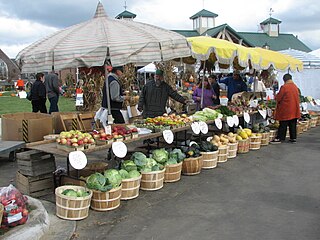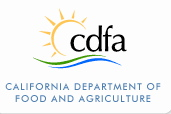Related Research Articles

The Federal Meat Inspection Act of 1906 (FMIA) is an American law that makes it illegal to adulterate or misbrand meat and meat products being sold as food, and ensures that meat and meat products are slaughtered and processed under strictly regulated sanitary conditions. These requirements also apply to imported meat products, which must be inspected under equivalent foreign standards. United States Department of Agriculture (USDA) inspection of poultry was added by the Poultry Products Inspection Act of 1957 (PPIA). The Food, Drug, and Cosmetic Act authorizes the Food and Drug Administration (FDA) to provide inspection services for all livestock and poultry species not listed in the FMIA or PPIA, including venison and buffalo. The Agricultural Marketing Act authorizes the USDA to offer voluntary, fee-for-service inspection services for these same species.

A farmers' market is a physical retail marketplace intended to sell foods directly by farmers to consumers. Farmers' markets may be indoors or outdoors and typically consist of booths, tables or stands where farmers sell their produce, live animals and plants, and sometimes prepared foods and beverages. Farmers' markets exist in many countries worldwide and reflect the local culture and economy. The size of the market may be just a few stalls or it may be as large as several city blocks. Due to their nature, they tend to be less rigidly regulated than retail produce shops.

Food policy is the area of public policy concerning how food is produced, processed, distributed, purchased, or provided. Food policies are designed to influence the operation of the food and agriculture system balanced with ensuring human health needs. This often includes decision-making around production and processing techniques, marketing, availability, utilization, and consumption of food, in the interest of meeting or furthering social objectives. Food policy can be promulgated on any level, from local to global, and by a government agency, business, or organization. Food policymakers engage in activities such as regulation of food-related industries, establishing eligibility standards for food assistance programs for the poor, ensuring safety of the food supply, food labeling, and even the qualifications of a product to be considered organic.

The American Meat Institute (AMI) was the oldest and largest trade association representing the U.S. meat and poultry industry. In 2015, it was merged into the North American Meat Institute (NAMI).

Food safety is used as a scientific method/discipline describing handling, preparation, and storage of food in ways that prevent foodborne illness. The occurrence of two or more cases of a similar illness resulting from the ingestion of a common food is known as a food-borne disease outbreak. This includes a number of routines that should be followed to avoid potential health hazards. In this way, food safety often overlaps with food defense to prevent harm to consumers. The tracks within this line of thought are safety between industry and the market and then between the market and the consumer. In considering industry-to-market practices, food safety considerations include the origins of food including the practices relating to food labeling, food hygiene, food additives and pesticide residues, as well as policies on biotechnology and food and guidelines for the management of governmental import and export inspection and certification systems for foods. In considering market-to-consumer practices, the usual thought is that food ought to be safe in the market and the concern is safe delivery and preparation of the food for the consumer. Food safety, nutrition and food security are closely related. Unhealthy food creates a cycle of disease and malnutrition that affects infants and adults as well.

The California Department of Food and Agriculture (CDFA) is a cabinet-level agency in the government of California. Established in 1919 by the California State Legislature and signed into law by Governor William Stephens, the Department of Food and Agriculture is responsible for ensuring the state's food safety, the protection of the state's agriculture from invasive species, and promoting the California agricultural industry.

Richard Allen Raymond was Under Secretary of Agriculture for Food Safety from 2005-2009. His nomination was announced and sent to the Senate on May 26, 2005. He was confirmed on July 1 and appointed on July 18.
President Chester A. Arthur signed the Animal Industry Act on May 29, 1884 creating the Bureau of Animal Industry (BAI), an organization that was established under the United States Department of Agriculture. It replaced the Veterinary Division that had been created by the Commissioner of Agriculture in 1883, which had taken over for the Treasury Cattle Commission, Department of Treasury.
Adulteration is a legal offence and when the food fails to meet the legal standards set by the government, it is said to have been Adulterated Food. One form of adulteration is an addition of another substance to a food item in order to increase the quantity of the food item in raw form or prepared form, which results in the loss of actual quality of food item. These substances may be either available food items or non-food items. Among meat and meat products some of the items used to adulterate are water or ice, carcasses, or carcasses of animals other than the animal meant to be consumed. In the case of seafood, adulteration may refer to species substitution (mislabeling), which replaces the species identified on the product label with another species, or undisclosed processing methods, in which treatments such as additives, excessive glazing, or short-weighting are not disclosed to the consumer.
Amenable species is a term used within the context of USDA's meat and poultry inspection program to signify exotic species that might be added to the laws and thus be eligible for mandatory federal inspection, which is taxpayer-funded. An exotic species is considered an amenable species if its anatomy and biology are substantially the same as the animals currently inspected. The Poultry Products Inspection Act was expanded in 2001 to cover ostrich, rhea, and emu (ratites) because USDA determined that the hazards they present to food safety are essentially the same as those posed by chickens, turkeys, ducks, etc., and the existing contamination detection and prevention systems are sufficient to control them. Buffalo have been considered for inclusion under the Federal Meat Inspection Act because they are bovine species. Deer and elk, on the other hand, are cervids, and pose hazards for food safety that are not yet fully known or controlled for under the existing meat inspection system. The term non-amenable sometimes is used to describe cervids and certain other exotics, like rabbits, for example.

The Poultry Products Inspection Act of 1957 requires the United States Department of Agriculture's Food Safety and Inspection Service (FSIS) to inspect all domesticated birds when slaughtered and processed into products for human consumption. By regulation, FSIS has defined domesticated birds as chickens, turkeys, ducks, geese, and guinea fowl. Ratites were added in 2001. The primary goals of the law are to prevent adulterated or misbranded poultry and products from being sold as food, and to ensure that poultry and poultry products are slaughtered and processed under sanitary conditions. These requirements also apply to products produced and sold within states as well as to imports, which must be inspected under equivalent foreign standards.
The Organic Foods Production Act of 1990 (OFPA) authorizes a National Organic Program (NOP) to be administered by USDA's Agricultural Marketing Service (AMS). The program is based on federal regulations that define standard organic farming practices and on a National List of acceptable organic production inputs. Private and state certifiers visit producers, processors, and handlers to certify that their operations abide by the standards. Once certified, these operations may affix the USDA Organic Seal. USDA has established four distinct categories for labeling organic products—100 percent organic, organic, "made with" organic ingredients, and specific organic ingredients—and only 100 percent organic and organic categories can use the USDA Organic Seal. It is illegal for anyone to use the word "organic" on a product if it does not meet the standards set in the law and regulations. The regulations under the OFPA are intended to set uniform minimum standards for organic production. However, states may adopt additional requirements after review and approval by USDA. AMS re-accredits certifying agents every 5 years, maintains federal oversight to assure truth in labeling, and provides assurance that imported organic products have been produced under standards that are equivalent to the U.S. standards.

Raw meat generally refers to any type of uncooked muscle tissue of an animal used for food. In the meat production industry, the term ‘meat’ refers specifically to mammalian flesh, while the words ‘poultry’ and ‘seafood’ are used to differentiate between the tissue of birds and aquatic creatures.

The Food Safety and Inspection Service (FSIS), an agency of the United States Department of Agriculture (USDA), is the public health regulatory agency responsible for ensuring that United States' commercial supply of meat, poultry, and egg products is safe, wholesome, and correctly labeled and packaged. The FSIS draws its authority from the Federal Meat Inspection Act of 1906, the Poultry Products Inspection Act of 1957 and the Egg Products Inspection Act of 1970. The FSIS also acts as a national health department and is responsible for the safety of public food-related establishments as well as business investigation.

Ground turkey, or minced turkey, is a mixture of dark and light turkey meat with remaining skin and visible fat processed together until a "ground" form emerges. The turkey meat, skin, and fat is taken off the bone and processed with additives. The final product has specific characteristics that appeal to customers, including a non pink color and non crumbly texture. The composition of ground turkey is driven by market demand, availability, and meat prices. The majority of ground turkey is made from excess thighs and drumsticks rather than the more costly breast meat. Ground turkey is a common low-fat alternative for ground beef.
The Ohio Department of Agriculture (ODA) is the administrative department of the Ohio state government responsible for ensuring the safety of the food supply, to maintain the health of animals and plant life, to create economic opportunities for farmers, food processors and agribusinesses, and to inspect amusement park rides in the state of Ohio.

The 2018 American salmonella outbreak was an American foodborne disaster that started in Iowa, spreading to 7 other states, sickening as many as 265 people, killing one, with 94 hospitalized. Ready-to-eat chicken salad was produced by Iowa-based Triple T Specialty Meats Inc. between January 2 and February 7 for distribution in Fareway grocery stores. Salad was sold in containers of various weights at Fareway stores deli from January 4 to February 9. Total of approximately 20 630 pounds of chicken were deemed contaminated with Salmonella Typhimurium at the time of recall on February 21.

Food safety in the United States relates to the processing, packaging, and storage of food in a way that prevents food-borne illness within the United States. The beginning of regulation on food safety in the United States started in the early 1900s, when several outbreaks sparked the need for litigation managing food in the food industry. Over the next few decades, the United States created several government agencies in an effort to better understand contaminants in food and to regulate these impurities. Many laws regarding food safety in the United States have been created and amended since the beginning of the 1900s.
Antibiotics in poultry farming in America is the controversial prophylactic use of antibiotics in the country's poultry farming industry. This does not represent the position in other countries.
The Grocery Manufacturers of America (GMA) is a food lobby group. It has existed since at least 1946. GMA "was the largest contributor of honoraria to US Senators in 1976". It was referred to as "the (American) food industry's power broker" in 1979, when its membership roll included 134 large corporations. In 1985, the Grocery Manufacturers of America was an incorporated association in Delaware. The GMA is a Political Action Committee.
References
- ↑ American Public Health Association v. Butz, 511F.2d331 (D.C. Cir.1974).
- ↑ "American Public Health Association v. Butz". December 19, 1974. Retrieved 2015-10-15.
- ↑ "Salmonella, Ground Beef, and Silly "American Housewives"". Daily Kos . August 7, 2009. Retrieved 2015-10-15.
- ↑ "A Reasonable Proposal for Safer Meat". Food safety news. March 14, 2015. Retrieved 2015-12-25.